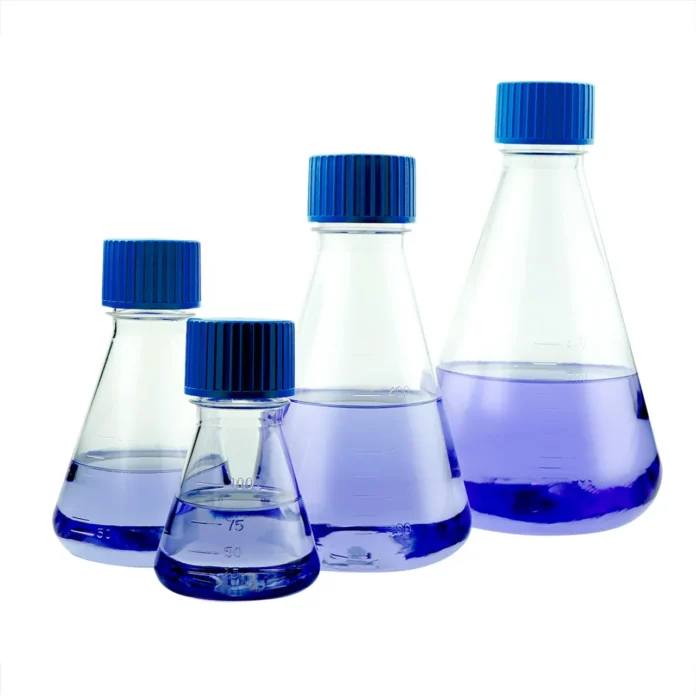In a chemistry lab, every tool has a specific job. One common piece of equipment is the Erlenmeyer flask. But there’s a part of it that doesn’t always get the attention it deserves—the Erlenmeyer flask cap. Even though it’s small, the cap plays an important role in chemical reactions.
In this blog, we’ll explore why this flask cap is important in chemical reactions. We’ll look at how it helps during experiments, the different types of caps available, and how to choose the right one. Whether you’re new to chemistry or have some experience, this information can help you better understand your lab work.
What is an Erlenmeyer Flask?
Before we talk about the cap, let’s first understand what an Erlenmeyer flask is. An Erlenmeyer flask is a type of glass container used in labs. It has a wide, flat bottom and a narrow neck. This shape makes it easy to mix liquids by swirling them around without spilling. It’s named after Emil Erlenmeyer, a chemist who created it in 1860. The flask is used in many different types of experiments.
Why is the Erlenmeyer Flask Cap Important?
The cap on an Erlenmeyer flask may seem like a small detail, but it’s actually very important. Here’s why:
1. Keeping Out Contaminants
One of the main jobs of the Erlenmeyer flask cap is to keep the contents inside the flask clean. In a lab, dust, bacteria, and other particles can easily get into an open container. These contaminants can ruin an experiment. The cap keeps these unwanted things out, making sure your results are accurate.
2. Holding In Volatile Substances
Some chemicals can easily evaporate and escape into the air. If your experiment uses these kinds of chemicals, the cap helps keep them inside the flask. This is important for safety, especially when working with harmful substances. It also ensures that the chemicals don’t evaporate too quickly, which could change the results of your experiment.
3. Maintaining the Right Conditions
Certain chemical reactions need specific conditions, like the right temperature or pressure. The Erlenmeyer flask cap helps maintain these conditions by sealing the flask. This is crucial for reactions that are sensitive to changes in the environment. By using a cap, you can make sure your experiment goes as planned.
4. Reducing Evaporation
When working with liquids, evaporation can be a problem. If too much liquid evaporates, it can affect the concentration of the chemicals in your experiment. The cap helps reduce evaporation by sealing the flask. This is especially important when using expensive or rare chemicals, as it ensures you get accurate and consistent results.
Different Types of Erlenmeyer Flask Caps
There are several types of caps for Erlenmeyer flasks, each with its own use. The following are a few of the more typical ones:
1. Rubber Stoppers
Rubber stoppers are widely used because they provide a good seal. They come in different sizes to fit various flask openings. Rubber stoppers are easy to use and work well for many types of experiments.
2. Screw Caps
Screw caps are another common type. They twist onto the flask’s neck and create a tight seal. Screw caps are especially useful when you need to shake or swirl the flask because they stay securely in place. They are often made of plastic or metal.
3. Glass Stoppers
For experiments involving chemicals that might react with rubber or plastic, glass stoppers are a good choice. Glass doesn’t react with most chemicals, making it ideal for sensitive reactions. However, glass stoppers are more fragile and can break if not handled carefully.
4. Vented Caps
In some experiments, you might need to allow gases to escape while still keeping the contents clean. Vented caps have a small hole or filter that lets gases out without letting contaminants in. These are useful for reactions that produce gas or need to breathe.
How to Choose the Right Erlenmeyer Flask Cap
Choosing the right cap for your Erlenmeyer flask is important. Here are some suggestions to assist you in selecting the best option:
1. Think About the Chemicals You’re Using
Make sure the cap material is compatible with the chemicals in your experiment. For example, rubber stoppers might not be the best choice for strong acids, as the acid could damage the rubber. In such cases, a glass stopper or a chemically resistant plastic cap would be better.
2. Consider How Secure the Seal Needs to Be
If you need to shake or mix the contents of the flask, a secure seal is important to prevent leaks. Screw caps are often the best choice for this because they provide a tight seal that won’t come loose.
3. Decide If You Need Venting
Some experiments produce gas or need to release pressure. If that’s the case, a vented cap would be the best option. It allows gases to escape while keeping the contents protected from contamination.
4. Think About How Often You’ll Use the Cap
If you plan to use the cap multiple times, durability is important. Screw caps and glass stoppers are generally more durable and can be reused many times. Rubber stoppers, on the other hand, may wear out faster, especially if exposed to harsh chemicals.
Conclusion
The Erlenmeyer flask cap is a small but important part of many chemical reactions. It helps prevent contamination, keeps volatile substances contained, maintains the right reaction conditions, and reduces evaporation. All of these factors are crucial for getting accurate and reliable results in your experiments.
When choosing a cap, consider the chemicals you’re using, how secure the seal needs to be, whether you need venting, and how often you’ll use the cap. By paying attention to these details, you can ensure that your experiments are successful.
Remember, in the lab, even small details like the cap on your Erlenmeyer flask can make a big difference. So, next time you set up an experiment, don’t forget to choose the right cap—it could be the key to achieving the results you’re looking for.



